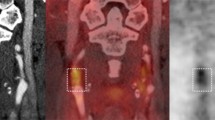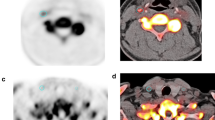Abstract
Objective
To evaluate the role of [18F]-fluorodeoxyglucose positron emission tomography/computer tomography [18F-FDG PET/CT] comparing target background ratio (TBR) and standardized uptake value (SUV) with the histopathological inflammatory status of the carotid plaques.
Background
Vulnerable carotid plaques are the primary cause of acute cerebrovascular events. 18F-FDG PET/CT represents a morpho-functional technique able to identify the highly inflamed and most vulnerable carotid plaques. Several literature studies experimented this new method to identify vascular inflammation, but few have effectively compared PET/CT results with plaque histological data and no studies had directly compared TBR to SUV.
Methods
Thirty-two consecutive patients (20 men and 12 women, mean age 74 ± 8 years) undergoing carotid endarterectomy were enrolled and studied with carotid 18F-FDG PET/CT. Maximum and mean SUV and TBR were used to quantify 18F-FDG uptake while surgical specimens were analyzed by optical microscopy to identify inflamed carotid plaques, with evaluation of macrophages infiltration by mean of immunohistochemistry. On the basis of the presence of inflammation at the histological analysis, we divided population in two groups: group A (n = 12) patients with inflamed carotid plaques and group B (n = 20) patients with non-inflamed ones, then crossed and evaluated the histological data with 18F-FDG PET/CT findings.
Results
SUV max and SUV mean values resulted higher in group A (respectively, 2.14 ± 0.77 and 1.99 ± 0.68) than in group B (respectively, 1.79 ± 0.37 and 1.64 ± 0.34) without reaching a statistical significance (p = ns). TBR max and TBR mean values resulted higher in group A (respectively, 1.42 ± 0.32 and 1.34 ± 0.26) than in group B (respectively, 1.16 ± 0.19 and 1.03 ± 0.20) with a statistically significant differences between the two groups and carotid inflammation (respectively, p < 0.01 and p < 0.001).
Conclusion
TBR (max and mean values) is a more reliable parameter than SUV in identifying inflamed plaques. Although limited by the small population analyzed, our results suggest the important role of 18F-FDG PET/CT, using TBR, in identification of high-risk carotid atherosclerotic plaques.



Similar content being viewed by others
References
Roger VL, Go AS, Lloyd-Jones DM, Benjamin EJ, Berry JD, Borden WB, et al. Executive summary: heart disease and stroke statistics—2012 update: a report from the American Heart Association. Circulation. 2012;125:188–97.
Sitzer M, Trostdorf F. The unstable carotid stenosis: definition and biological processes. Hamostaseologie. 2003;23:61–6.
Libby P. Inflammation in atherosclerosis. Nature. 2002;420:868–74.
Chaturvedi S, Bruno A, Feasby T, Holloway R, Benavente O, Cohen SN, et al. Carotid endarterectomy—an evidence-based review: report of the Therapeutics and Technology Assessment Subcommittee of the American Academy of Neurology. Neurology. 2005;65:794–801.
Tawakol A, Migrino RQ, Hoffmann U, Abbara S, Houser S, Gerwitz H, et al. Noninvasive in vivo measurement of vascular inflammation with F-18 fluorodeoxyglucose positron emission tomography. J Nucl Cardiol. 2005;12:294–301.
de Vries Wallis BM, van Dam GM, Tio RA, Hillebrands JL, Slart RH, Zeebregts CJ. Current imaging modalities to visualize vulnerability within the atherosclerotic carotid plaque. J Vasc Surg. 2008;48:1620–9.
Meerwaldt R, Slart RH, van Dam GM, Luijckx GJ, Tio RA, Zeebregts CJ. PET/SPECT imaging: from carotid vulnerability to brain viability. Eur J Radiol. 2010;74:104–9.
Tahara N, Kai H, Nakaura H, Mizoguchi M, Ishibashi M, Kaida H, et al. The prevalence of inflammation in carotid atherosclerosis: analysis with fluorodeoxyglucose-positron emission tomography. Eur Heart J. 2007;28:2243–8.
Ogawa M, Ishino S, Mukai T, Asano D, Teramoto N, Watabe H, et al. (18)F-FDG accumulation in atherosclerotic plaques: immunohistochemical and PET imaging study. J Nucl Med. 2004;45:1245–50.
Riou LM, Broisat A, Dimastromatteo J, Pons G, Fagret D, Ghezzi C. Pre-clinical and clinical evaluation of nuclear tracers for the molecular imaging of vulnerable atherosclerosis: an overview. Curr Med Chem. 2009;16:1499–511.
Figueroa AL, Subramanian SS, Cury RC, Truong QA, Gardecki JA, Tearney GJ, et al. Distribution of inflammation within carotid atherosclerotic plaques with high-risk morphological features: a comparison between positron emission tomography activity, plaque morphology, and histopathology. Circ Cardiovasc Imaging. 2012;5:69–77.
Eckstein HH. Evidence-based management of carotid stenosis: recommendations from international guidelines. J Cardiovasc Surg (Torino). 2012;53:S3–13.
Mancia G, De Backer G, Dominiczak A, Cifkova R, Fagard R, Germano G, et al. 2007 ESH-ESC Practice Guidelines for the Management of Arterial Hypertension: ESH-ESC Task Force on the Management of Arterial Hypertension. J Hypertens. 2007;25:1751–62.
American Diabetes Association. Diagnosis and classification of diabetes mellitus. Diabetes Care. 2010;33:S62–9.
National Cholesterol Education Program (NCEP) Expert Panel on Detection, Evaluation, and Treatment of High Blood Cholesterol in Adults (Adult Treatment Panel III). Third Report of the National Cholesterol Education Program (NCEP) Expert Panel on Detection, Evaluation, and Treatment of High Blood Cholesterol in Adults (Adult Treatment Panel III) Final Report. Circulation. 2002;106:3143–421.
Martínez JA, Kearney JM, Kafatos A, Paquet S, Martínez-González MA. Variables independently associated with self-reported obesity in the European Union. Public Health Nutr. 1999;2:125–33.
Silberberg JS, Wlodarczyk J, Fryer J, Robertson R, Hensley MJ. Risk associated with various definitions of family history of coronary heart disease. The Newcastle Family History Study II. Am J Epidemiol. 1998;147:1133–9.
Touboul PJ, Hennerici MG, Meairs S, Adams H, Amarenco P, Bornstein N, et al. Mannheim carotid intima-media thickness consensus (2004–2006). Cerebrovasc Dis. 2007;23:75–80.
Pignoli P, Tremoli E, Poli A, Oreste P, Paoletti R. Intimal plus medial thickness of the arterial wall: a direct measurement with ultrasound imaging. Circulation. 1986;74:1399–406.
Arnold JA, Modaresi KB, Thomas N, Taylor PR, Padayachee TS. Carotid plaque characterization by duplex scanning: observer error may undermine current clinical trials. Stroke. 1999;30:61–5.
Kim TY, Choi JB, Kim KH, Kim MH, Shin BS, Park HK. Routine shunting is safe and reliable for cerebral perfusion during carotid endarterectomy in symptomatic carotid stenosis. Korean J Thorac Cardiovasc Surg. 2012;45:95–100.
Hellings WE, Pasterkamp G, Vollebregt A, Seldenrijk CA, De Vries JP, Velema E, et al. Intraobserver and interobserver variability and spatial differences in histologic examination of carotid endarterectomy specimens. J Vasc Surg. 2007;46:1147–54.
Tawakol A, Migrino RQ, Bashian GG, Bedri S, Vermylen D, Cury RC, et al. In vivo 18F-fluorodeoxyglucose positron emission tomography imaging provides a noninvasive measure of carotid plaque inflammation in patients. J Am Coll Cardiol. 2006;48:1818–24.
Rudd JH, Warburton EA, Fryer TD, Jones HA, Clark JC, Antoun N, et al. Imaging atherosclerotic plaque inflammation with [18F]-fluorodeoxyglucose positron emission tomography. Circulation. 2002;105:2708–11.
Tahara N, Kai H, Ishibashi M, Nakaura H, Kaida H, Baba K, et al. Simvastatin attenuates plaque inflammation: evaluation by fluorodeoxyglucose positron emission tomography. J Am Coll Cardiol. 2006;48:1825–31.
Chen W, Dilsizian V. (18)F-fluorodeoxyglucose PET imaging of coronary atherosclerosis and plaque inflammation. Curr Cardiol Rep. 2010;12:179–84.
Folco EJ, Sheikine Y, Rocha VZ, Christen T, Shvartz E, Sukhova GK, et al. Hypoxia but not inflammation augments glucose uptake in human macrophages. J Am Coll Cardiol. 2011;58:603–14.
Sheikine Y, Akram K. FDG-PET imaging of atherosclerosis: Do we know what we see? Atherosclerosis. 2010;211:371–80.
Graebe M, Pedersen SF, Højgaard L, Kjaer A, Sillesen H. 18FDG PET and ultrasound echolucency in carotid artery plaques. JACC Cardiovasc Imaging. 2010;3:289–95.
Martinet W, Schrijvers DM, De Meyer GR. Molecular and cellular mechanisms of macrophage survival in atherosclerosis. Basic Res Cardiol. 2012;107:297.
Rudd JH, Myers KS, Bansilal S, Machac J, Pinto CA, Tong C, et al. Atherosclerosis inflammation imaging with 18F-FDG PET: carotid, iliac, and femoral uptake reproducibility, quantification, methods, and recommendations. J Nucl Med. 2008;49:871–8.
Shepherd PR, Kahn BB. Glucose transporters and insulin action implications for insulin resistance and diabetes mellitus. N Engl J Med. 1999;341:248–57.
Wahl RL, Henry CA, Ethier SP. Serum glucose: effects on tumor and normal tissue accumulation of 2-[F-18]-fluoro-2-deoxy-d-glucose in rodents with mammary carcinoma. Radiology. 1992;183:643–7.
Deichen JT, Prante O, Gack M, Schmiedehause K, Kuwert T. Uptake of [(18)F]fluorodeoxyglucose in human monocyte-macrophages in vitro. Eur J Nucl Med Mol Imaging. 2003;30:267–73.
Niccoli Asabella A, Iuele FI, Merenda N, Pisani AR, Notaristefano A, Rubini G. 18F-FDG PET/CT diabetes and hyperglycaemia. Nucl Med Rev Cent East Eur. 2013;16(2):57–61.
Rudd JH, Myers KS, Bansilal S, Machac J, Woodward M, Fuster V, et al. Relationships among regional arterial inflammation, calcification, risk factors, and biomarkers a prospective fluorodeoxyglucose positron-emission tomography/computed tomography imaging study. Circ Cardiovasc Imaging. 2009;2:107–15.
Derlin T, Wisotzki C, Richter U, Apostolova I, Bannas P, Weber C, et al. In vivo imaging of mineral deposition in carotid plaque using 18F-sodium fluoride. J Nucl Med. 2011;52:362–8.
Conflicts of interest
None declared.
Author information
Authors and Affiliations
Corresponding author
Rights and permissions
About this article
Cite this article
Niccoli Asabella, A., Ciccone, M.M., Cortese, F. et al. Higher reliability of 18F-FDG target background ratio compared to standardized uptake value in vulnerable carotid plaque detection: a pilot study. Ann Nucl Med 28, 571–579 (2014). https://doi.org/10.1007/s12149-014-0850-9
Received:
Accepted:
Published:
Issue Date:
DOI: https://doi.org/10.1007/s12149-014-0850-9




